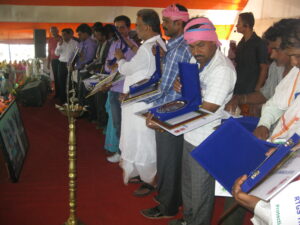The tribal farmers of Tikamgarh district in Bundelkhand region earned respect at the national level by cultivating and conserving their traditional small millet varieties. The germplasm of these promising traditional varieties were deposited in the National Gene Bank for utilizing them for crop improvement programmes. Thus, practice of traditional conservation by farmers provided valuable raw materials to the country, from developing many good varieties of small millets in the future.
The importance of small millets increased considerably during Covid-19 pandemic. Millet cultivation was considered as an obligation of small and marginal farmers. It was often believed that they cultivated them to meet economic needs, being unable to spend on chemical inputs like fertilizers, pesticides etc. In reality, they cultivated them based on traditional, social and cultural backgrounds.
The Bundelkhand region has an excellent history of conservation of coarse grains and small millets. Besides having a suitable climate for their cultivation, it is linked to coarse grain preferences of locals on food plate. During different seasons coinciding with ceremonies and festivals, diverse dishes prepared from small millets can be seen even today. Thus, lots of efforts have been made by the tribal farmers in conserving traditional varieties of coarse millets.
The farmers of Tikamgarh districts in Bundelkhand region of Madhya Pradesh have been conserving many varieties of small millets for the past many years. They are recognized by their local names – Sawan, Cheena, Sathiya, Fikaar etc. The cultivators are deeply familiar with their physiological and reproductive characteristics. The mythological beliefs and traditions prevailing in the society associated with these varieties have also been explicitly maintained in local folk literature. For instance, in well-known temples of the region, such as the famous Ramraja temple of Orchha and the renowned Kundeshwar temple at the district headquarters, small millets form the key ingredient in the offerings to the deities in the form of ‘prasaad’.
Efforts of Krishi Vigyan Kendra
Krishi Vigyan Kendra, Tikamgarh has been anchoring a project on awareness of “Farmers Rights – Plant Varieties and Farmers Rights Protection Act 2001” for the last 8 years. Under the project, efforts were made to conserve the traditional crop species available in the district, preserving the germplasm in the National Gene Bank, and giving rights and recognition to those farmers who were conserving and cultivating them.

Tikamgarh farmers were felicitated for conserving 12 traditional varieties of great value
Initially, intensive surveys were conducted to find out which crops, varieties especially traditional varieties were being cultivated by the tribal farmers in remote areas. Training programs were organized every year since 2013-14 in which more than 650 farmers got trained on conservation aspects. The rare and endangered species of different crops of the district were publicized through exhibitions to encourage locals to take up their conservation. As a result of intensive and conducting repeatedly conducting awareness programmes, varieties with certain unique characteristics could be identified. Along with other crops like oilseeds, pulses, spices and cereals, during 2013-14, 2014-15 and 2015-16, eleven, seven and thirty seven varieties of kodo millets respectively were collected from the farmers of the KVK adopted villages.
These identified varieties were sent to the National Gene Bank at National Bureau of Plant Genetic Resources (NBPGR), New Delhi. NBPGR conducted multi-locational yield trials of these selected varieties in the fields of its regional centers. Their distinctiveness was ascertained through by conducting DUS (Distinct, Uniform, Stable) test. The DUS testing is a way of determining whether a newly recognized variety differs from other existing varieties within the same species and also whether the traits reported are uniform and stable. After three years of multi-locational trials, the genes present in these rare varieties collected from 12 farmers of Tikamgarh district were found to be very prominent and useful. These varieties were not only found to be better in yield potential, but also useful in being resistant to insect-pests. These trials thus proved that wild species are generally resistant to insect diseases. Also, nutritionally, the quantity and quality of proteins found were better than other parallel varieties of the kodo millets in the country. The fiber content of these varieties was found to be in the range of 11-13gm/100 gm that is significantly higher than refined wheat flour or rice (<3 gm/100 gm).
These farmer’s impressive efforts were communicated at the national level by the Krishi Vigyan Kendra, highlighting how traditional conservation practices of farmers could lead to development of good varieties in future. Especially, keeping in view the quality and their usefulness in future in crop improvement programmes, these 12 millet farmers of Tikamgarh were honored by the then Honourable Union Agriculture Minister Shri Radha Mohan Singh on 18 April 2017 in a public function. As an honor and award, each farmer was given a letter of honor and an honorarium of Rupees One Lakh. The Minister in his address, said “this joint effort of Krishi Vigyan Kendra, Tikamgarh and local farmers is indicating the importance of Indian traditional knowledge along with conservation of valuable plant varieties and should be considered as a national benchmark”.
Rama bai of Soriyana village, reacted, “I never dreamt that our tradition would get us such a big award at the national level”.
Although, in general, millets have been relegated as ‘coarse’ grains, their rich nutritional characteristics, short growing period and long survival in storage make them the most suitable option in India. These farmers of Bundelkhand have opened the door for developing mechanisms for millet improvement but also influencing millet cultivation by larger number of farmers. Due to higher production, they also got buyers. In this way, the kodo millet, which was grown only for maintenance of tradition, has now become a means of earning.
R.K.Prajapati, B.S.Kirar and Yogranjan
R.K.Prajapati
Scientist (Plant Pathology)
Krishi Vigyan Kendra, Tikamgarh, M.P.-472001, India
E-mail: rkiipr@yahoo.com
B.S.Kirar
Principal Scientist and Head
Krishi Vigyan KendrA, Tikamgarh, M.P.-472001, India
E-mail: kvktikamgarh@rediffmail.com
Yogranjan Singh
Scientist (Biotechnogy)
College of Agriculture, Tikamgarh, M.P.-472001, India
E-mail: yogranjan@gmail.com









